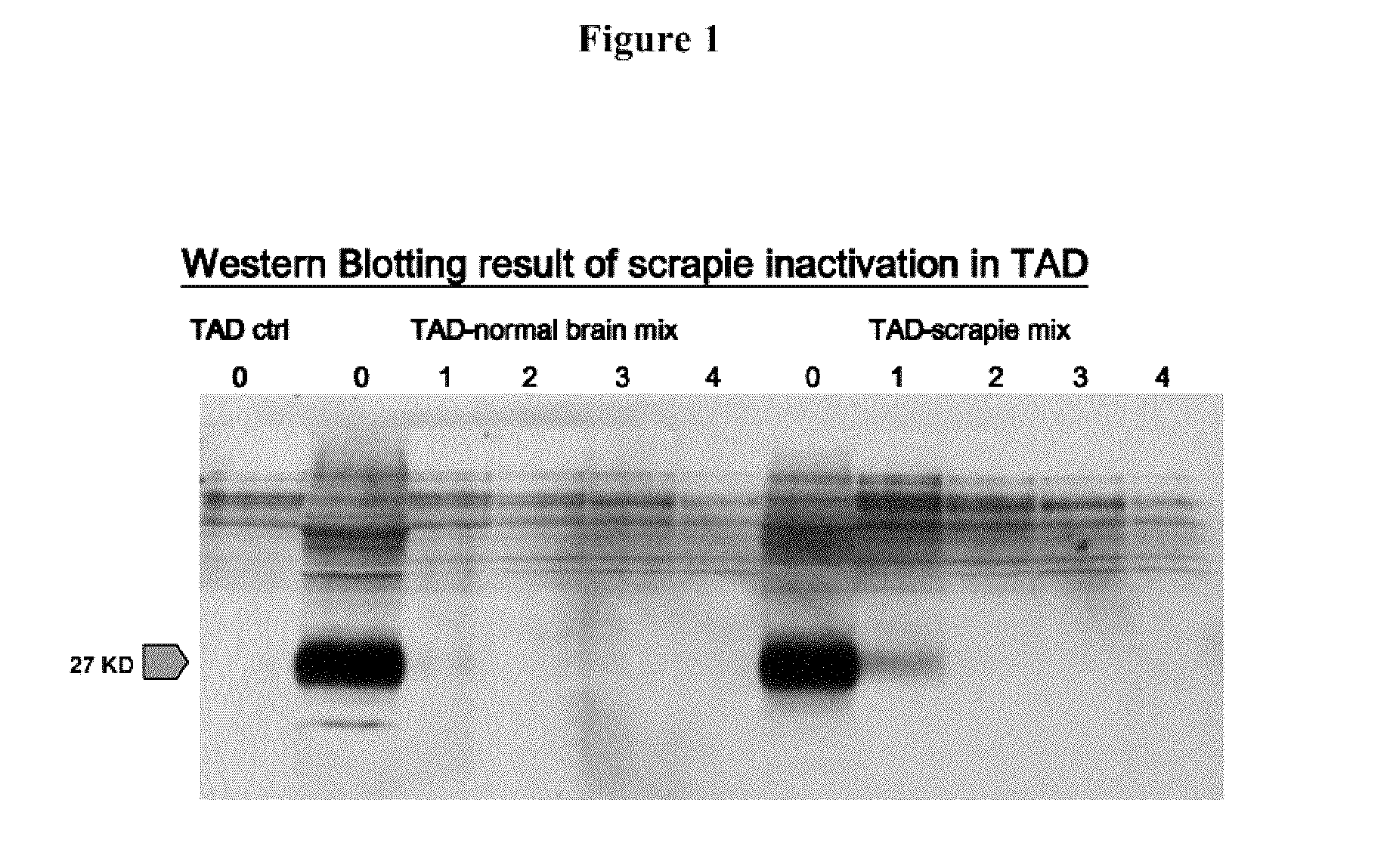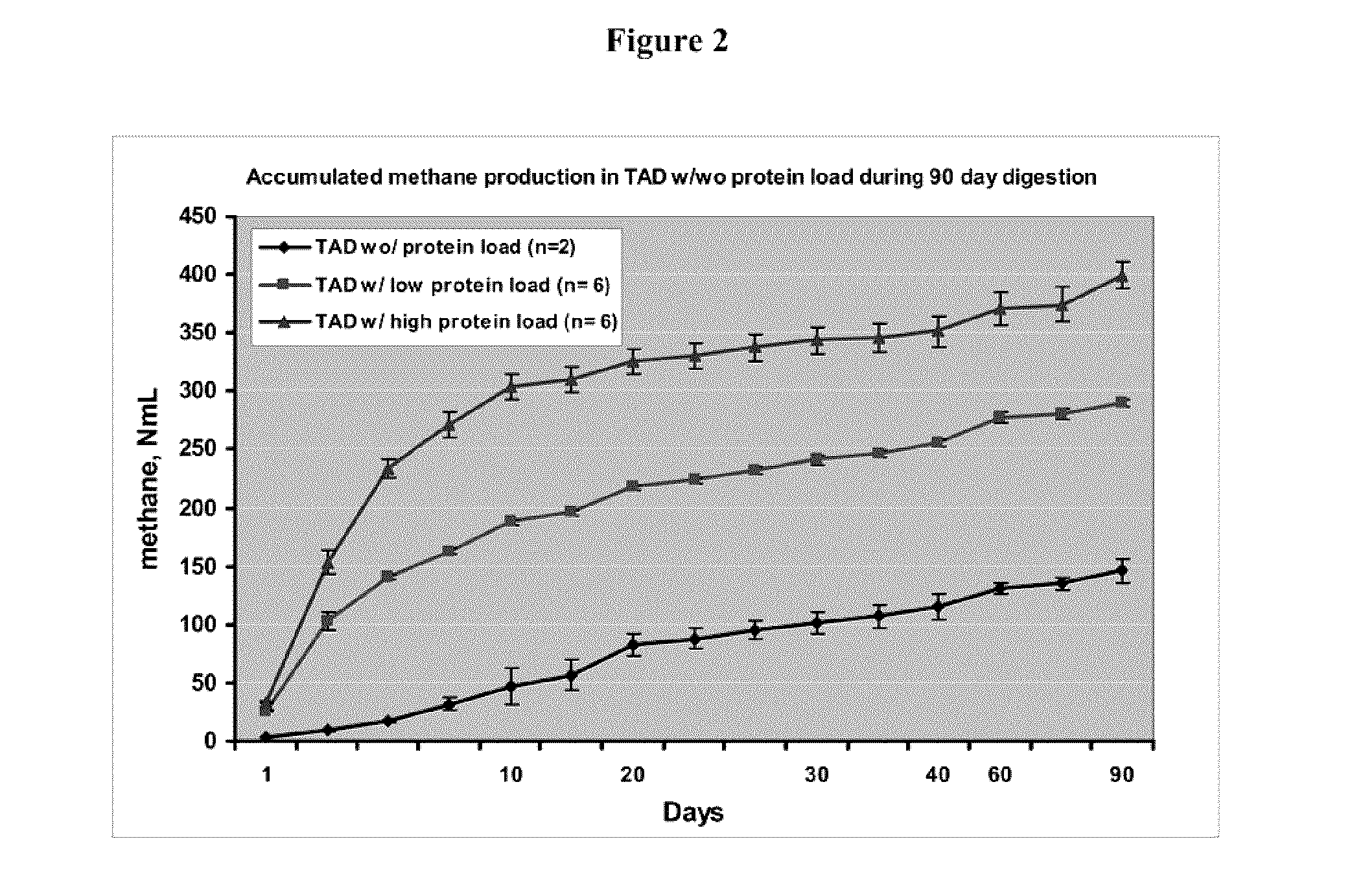Use of anaerobic digestion to destroy antibiotics in organic waste
- Summary
- Abstract
- Description
- Claims
- Application Information
AI Technical Summary
Benefits of technology
Problems solved by technology
Method used
Image
Examples
example 1
Thermophilic Anaerobic Digestion (TAD) Process Eliminates Scrapie Prion and Enhances Biogas Production
[0113]Scrapie prion, one of the very resistant prions to proteinase K (PK) digestion, was used as a model in this experiment to demonstrate the effectiveness of the TAD process for prion destruction.
[0114]High-(4 g) and low-dose (2 g) of scrapie brain homogenate (20%) were spiked into the lab scale TAD digesters, with temperature set at 55° C. Digestion was allowed to continue in hatch mode for up to 90 days. About 5 mL of the digestate was taken from experimental and control groups at day 0, 10, 30, 60, and 90 for assessing scrapie degradation. Scrapie (PrPsc), obtained from the CFIA National Reference Lab, and cellular prion (PrPc) were recovered from the digestate using a buffer containing 0.5% SDS (recovery rate ˜75 to 82%). Both cellular and scrapie prion were resolved in 12.5% SDS-PAGE gel and detected by immunoblotting using a monoclonal antibody (F89, Sigma). Biogas producti...
example 2
Efficacy and Kinetics of BSE Elimination in Batch-TAD Under Optimal Conditions
[0117]Bovine brain tissue and other types of SRM tissues (such as spinal cord, lymph nodes or salivary glands) with confirmed BSE are obtained from the CFIA National BSE Reference Lab, and homogenized in phosphate buffered saline (PBS) on ice. A 20% brain homogenate alone or homogenate mixed with other tissues is spiked in diluted digestate (with final total solid of about 7%), which is obtained fresh from the IMUS™ demonstration plant in Vegreville, based on results of the studies described above. The whole procedure is carried out in a biosafety cabinet (class IIB) in a Biolevel III laboratory (e.g., in the Laboratory Building of Alberta Agriculture and Rural Development). Final content of the homogenate is about 2.5 and 5 grams (equivalent of fresh tissue) in TAD-tissue mixture in a low- and high-dose group, respectively. The mixture is then placed into a screw-capped, safety-coated glass bottle. Anaero...
example 3
In Vitro Cyclic Amplification Misfolding Protein (iCAMP) Assay with High Sensitivity for Assessing the Completion of BSE Prion Destruction
[0122]Abnormal isoform of prion proteins (e.g., PrPsc) retain infectivity even after undergoing routine sterilization processes. A sensitive method to detect the infectivity is a bioassay. However, the result of such bioassay can only be obtained after several hundred days. Hence, cyclic amplification of misfolding protein (CAMP) provides an attractive alternative in which PrPsc can be amplified in vitro for assessing prion inactivation. Since three rounds of CAMP require only about 6 days, CAMP is much faster than the traditional bioassay.
[0123]An in vitro cyclic amplification mis-folding protein (iCAMP) method is developed herein for assessing the completion of BSE prion decontamination in TAD. Briefly, a 10% (w / v) homogenate of normal bovine brain and bovine brain with BSE is prepared in a conversion buffer. Specifically, iCAMP is set up with a...
PUM
 Login to View More
Login to View More Abstract
Description
Claims
Application Information
 Login to View More
Login to View More - R&D
- Intellectual Property
- Life Sciences
- Materials
- Tech Scout
- Unparalleled Data Quality
- Higher Quality Content
- 60% Fewer Hallucinations
Browse by: Latest US Patents, China's latest patents, Technical Efficacy Thesaurus, Application Domain, Technology Topic, Popular Technical Reports.
© 2025 PatSnap. All rights reserved.Legal|Privacy policy|Modern Slavery Act Transparency Statement|Sitemap|About US| Contact US: help@patsnap.com



